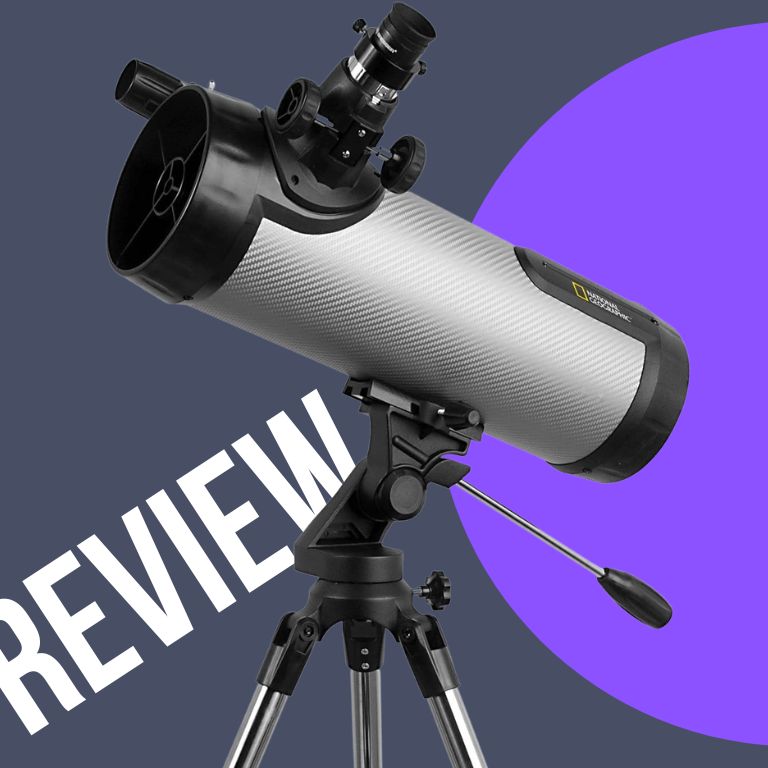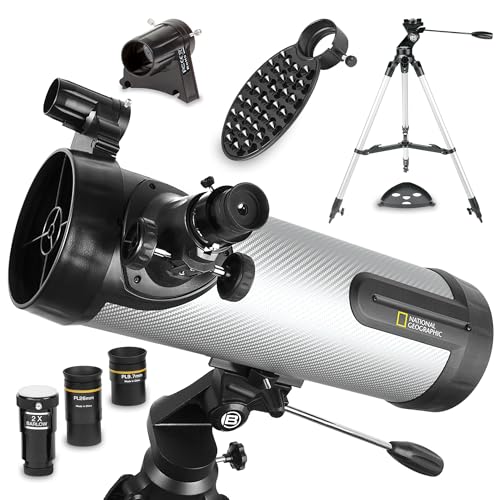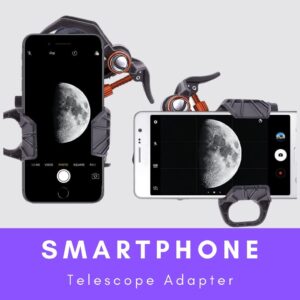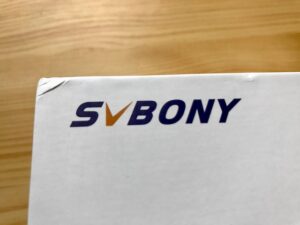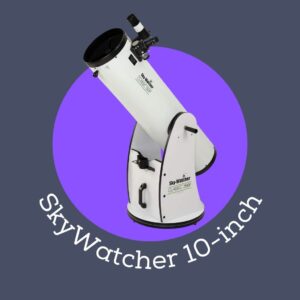This site contains affiliate links to products. I may receive a commission for purchases made through these links.
The National Geographic Telescope (NT114CF) is the perfect entry point for anyone exploring deep-sky wonders. With a 114mm aperture and a 500mm focal length, this telescope gives you a stunning view of some of the brightest Messier objects like the Orion nebula, Andromeda galaxy, or the Pleiades.
You can also view the Moon and easily spot its craters and terrain details.
Additionally, it comes with a host of accessories, including two Plossl eyepieces, an adjustable tripod, a Smartphone Camera Adapter, a 2X Barlow lens, a red dot viewfinder, Stellarium computer software download, and a star map.
In this review, we’ll unbox NT114CF’s key features, show you how to set it up, and use it. We will also list its pro and cons, the deep-sky objects you can see with the telescope, and why it’s worth the investment.
Let’s delve in!
Specifications of the National Geographic Telescope NT114CF
National Geographic NT114CF is a Newtonian carbon fiber reflector telescope that uses mirrors to produce images instead of lenses (refracting telescope).
It has a carbon-fiber body, which is an excellent feature among telescopes because it helps significantly reduce the instrument’s weight.
This telescope is the perfect choice for kids and beginners and has the following specifications:
- Newtonian reflector design
- Carbon-fiber tube
- 114mm mirror aperture
- 500mm focal length
- 26mm and 9.7mm Plossl eyepieces (19x and 51x magnification)
- 2x Barlow lens (doubling the eyepiece magnification)
- Fast focal ratio F/5.2
- Alt-azimuth mount
- Aluminum tripod
Read also: Maksutov Newtonian Telescopes (In-depth Guide)
What is included in the National Geographic Telescope NT114CF box?
The National Geographic NT114CF Telescope ships with everything you need to get started with stargazing. The following is a list of what is included in the box.
- Smartphone Adapter
- Stellarium software
- Red dot viewfinder and downloadable astronomy software
- Two 1.25″ Possl Eyepieces (9.7mm & 26mm)
- 2x Barlow Lens
- Pan and tilt control on an alt-azimuth mount
- Carbon fiber-look optical tube assembly
- Focus Wheel
- Full-length tripod w/ Accessory Tray
What is the magnification of the National Geographic Telescope NT114CF?
The National Geographic Telescope NT114CF ships with two Possl eyepieces (9.7mm & 26mm) and 2x Barlow Lens that provide magnifications ranging from 19x to 103x.
You may wonder how magnification, also called the power of the telescope, is calculated.
The magnification of a telescope is determined by its focal length and the eyepiece’s focal length. Using NT114CF as an example, magnification is calculated by dividing the focal length of this telescope (500mm) by the focal length of the eyepiece (26mm, 9.7mm), which will give you 19x and 51x magnification.
The included Barlow lens in the box can help double the eyepiece magnification to 38x and 103x. To achieve this magnification, place the Barlow lens into the eyepiece holder before placing the eyepiece onto the Barlow lens.
It’s important to note that while high power or magnification is good for viewing the Moon and planets, it’s better to use a low-power eyepiece for most deep-sky objects to achieve a larger field of view.
Some deep-sky objects are even larger than the Moon in the sky, and a low-power eyepiece will provide a better view of the entire object.
Also, note that magnification is not the only factor that determines the quality of the image. The aperture, the quality of the optics, and atmospheric conditions also play a significant role in the viewing experience.
You may also like: What Can You See With a 70mm Telescope?
How to set up the National Geographic Telescope NT114CF?
This telescope comes almost completely preassembled, so setting it up is relatively straightforward and can be done in a few simple steps:
Unbox and assemble the tripod
When you unbox the telescope, on the one hand, you will find the manual you can refer to as you go along. But be careful while unboxing, so the two boxes inside do not fall apart.
After removing the two boxes, you will find the spreader tripod plate that also serves as an eyepiece holder.
In one of the boxes is the telescope and in the other are the tripod and panhandler.
Open the box containing the tripod, spread out the legs, and push the spreader bar between the legs. Take the accessory tray and mount it on the spread bar by twisting it into a secure position.
You can use this tray to place your eyepieces and Barlow lenses during the stargazing session.
Assemble the mounting head
Next, take the mounting head, which has a metal construction. Take out the bolt on the bottom and place the head on the tripod. Then attach the bolt and tighten it up from the bottom.
When screwing the mounting head to the tripod, make sure it is not too tight that it can’t move.
You also need to thread the panhandle into the mounting head mouth hole. The panhandle controls the movement of the mount, and it also works as a lock for the altitude swivel. The azimuth lock knob is on the side of the mount head.
Mount the telescope
When the mounting head is secured and tightened, take the telescope tube with a dovetail mounted on the bottom and attach it to the mount with the knob.
Attach the red dot viewfinder
The last thing you need to do is attach the red dot viewfinder to the telescope’s top. Then choose the eyepiece that suits your viewing needs, Insert it into the focuser tube, and tighten the screws to keep it in place.
You may also like: Can I Use My Telescope Through a Window?
How to use the National Geographic Telescope NT114CF?
There are a few crucial things to note when using the National Geographic Telescope NT114CF or any other telescope.
First and foremost, NEVER look directly at the sun without a proper sun filter attached to the front of the telescope. Doing so can cause permanent damage to your eyes, so exercise caution, especially when using the telescope with children during the day.
Secondly, the NT114CF is an astronomical telescope, not a spotting scope, meaning its image is upside down. This is fine when stargazing because you won’t even notice that the image is upside down, but if you want to use it for terrestrial observation, it becomes a challenge.
To align the red dot finder during the day, find an object in the distance, such as a roof or a tree, center it in the eyepiece, and adjust the red dot using the knobs so that when you point it at an object in the sky at night, it will be centered in the eyepiece.
However, be cautious of the sun when doing this in the daytime if you don’t have a solar filter.
You’ll receive a star map in the box, but using a smartphone app like Star Chart for locating deep-sky objects is a good idea. We highly recommend that you learn about the skies and avoid using any sources of light while stargazing.
Your night vision adaptation can take a few minutes in a dark environment, and your surroundings highly impact the overall experience.
To get the best view, use the telescope in a dark area away from city light pollution and take the time to learn about the skies.
I often hear from people that they are disappointed by the telescope’s performance. Still, half of the successful stargazing experience is the dark skies and your night vision adaptation. So try not to use the smartphone to navigate across the night skies and learn it over time.
You may also like: Refractor vs Reflector Telescope (What Is The Difference)
Is collimation an issue with the NT114CF?
Collimation, which is the process of aligning the mirrors of a reflector telescope, is often seen as a drawback of Newtonian reflectors. This is because you must always align the primary and secondary mirrors to get the perfect image and experience from the reflecting telescope.
However, collimation is an easy process, and it’s easier with the National Geographic Telescope NT114CF.
The primary mirror of this telescope is permanently mounted and comes collimated from the factory. So you don’t have to bother with this procedure as this is now common practice for telescope manufacturers with smaller and less expensive reflecting telescopes.
However, you can still adjust the secondary mirror if necessary, although it should also come collimated from the factory.
Pros of the National Geographic NT114CF telescope
- The NT114CF is an affordable telescope option for beginners or anyone on a budget.
- Setting up and using the telescope is easy, making it an excellent telescope to purchase for children and beginners.
- The lightweight and compact design of the telescope makes it easy to transport to different observing locations.
- It adapts better to temperature change due to its carbon fiber tube feature.
- The telescope provides clear and crisp images of far-distant objects like the Moon and planets, making it a good choice for planetary observation.
Cons of the NT114CF telescope
- While collimation is not a major issue with the NT114CF, it can still be a hassle for some users to adjust the secondary mirror if necessary.
- The included tripod is not very sturdy and can affect the stability of the telescope during observing sessions
- Images are upside-down, hence can be confusing for terrestrial viewing.
You may also like: Is Celestron a Good Telescope Brand? (Read This First!)
Can you use a smartphone with the NT114CF telescope?
The box includes additional accessories like a smartphone adapter and a star map. The smartphone adapter is a basic one with suction cups, which allows you to capture images and videos with your smartphone camera when you attach it to the eyepiece holder.
However, I don’t find this adapter very useful as it only works well with some smartphones, and it can be dangerous as the smartphone can easily fall off if the surface is not smooth enough for the suction cups to hold.
I recommend using the adapter only if you modify it by strapping the smartphone to the adapter with a rubber band or something else.
What can you expect to see through the NT114CF telescope?
First, don’t expect to see anything like the pictures of the deep sky objects on the internet. These colorful and highly detailed images are made with expensive cameras and very long exposures.
With the NT114CF telescope, you can expect to see some of the brightest Messier objects like the Orion nebula, Andromeda galaxy, or the Pleiades.
As I said before, the dark sky is key for deep-sky observation. But regarding the planets, you don’t need a dark sky to see them, and you can observe them even from the city. You will see Jupiter with its moons and Saturn with its rings, but other planets will likely appear as tiny dots.
The most impressive experience with the NT114CF telescope will be observing the Moon. You can easily spot craters and terrain details, making it the best target for observing with this telescope.
You may also like to read: What Can You See Through a Telescope (Real Examples)
Is the National Geographic NT114CF telescope worth it?
Whether or not the National Geographic NT114CF telescope is worth it depends on what you’re looking for in a telescope.
If you’re a beginner or someone on a budget, and you’re interested in observing the Moon and planets, then the NT114CF is definitely worth it. However, it’s important to keep your expectations in check and not expect miracles from this telescope. It’s a great option for introducing kids to astronomy or using it for occasional entertainment during camping trips or barbecue nights in your backyard.
On the other hand, if you are serious about astronomy and willing to spend more, it may be worth considering a Dobsonian telescope like the Orion SkyQuest XT8. This is a great option for more enthusiastic beginners who want to delve deeper into stargazing and astronomy.
Read also: Best telescopes for kids
Takeaway – Explore the universe on a budget with the National Geographic Telescope NT114CF
In this review of the National Geographic NT114CF 114mm carbon fiber reflector telescope, we have covered its quality, including accessories, setup process, and potential viewing options.
This telescope has impressive light-gathering capability thanks to its good aperture size of 114mm given its affordable price.
The NT114CF is an excellent option for beginners or anyone on a budget. It’s easy to set up and use, provides decent optics, and comes with additional accessories like a smartphone adapter and a star map making it an enjoyable and practical tool for anyone new to stargazing.
If you want to get started with stargazing, the NT114CF is a great entry-level option.
You may also like:

